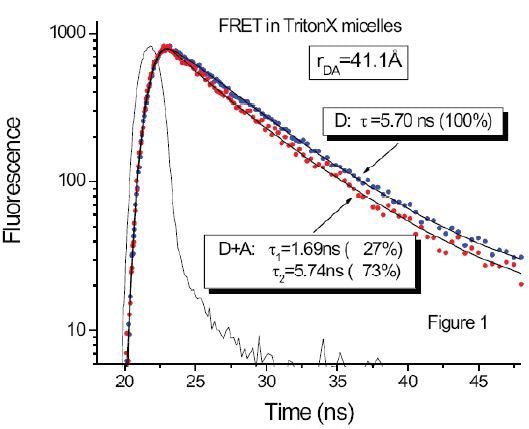The new simple, portable and powerful fluorescence lifetime system and the dedicated FRET calculator that comes standard with the new version of EasyLife V software is ideal to determine the distance between two fluorophores in a multi-phase system, such as micelles, vesicles, liposomes, or membranes.
Experiment
As an example, consider TritonX micellar solution in water with perylene added as the donor and Rhodamine B as the acceptor. Perylene is an aromatic hydrocarbon, virtually insoluble in water, will seek a highly hydrophobic environment and will be localized exclusively inside TritonX micelles.
The plot is shown in Figure 1.

Figure 1
Its fluorescence decay (trace D in the plot) is single exponential with the lifetime of 5.7ns. The Rhodamine B is a hydrophilic molecule and will be mostly in the aqueous phase, however some fraction will also diffuse in the micelles. When both D and A are confined to the same micelle, energy transfer may occur. The perylene decay after the addition of Rhodamine B is shown as trace D+A in the plot.
Now with the addition of the acceptor molecules, the decay is double exponential with the short lifetime of 1.69ns (27%) and the long lifetime of 5.74ns (73%), the latter being the same as for the donor alone (trace D).
Results and Conclusion
The following conclusion can now be drawn
- 27% of all micelles containing perylene also contain Rhodamine B acceptor and the FRET inside the micelles is quite efficient, since the donor lifetime was quenched to 1.69 ns.
- For the Rhodamine B molecules, which are in the aqueous phase the average distance is too great to cause FRET with the micelle-embedded perylene.
- To find the average distance between the D and A in a micelle, open the FRET Calculator, enter the lifetimes of D alone (5.7ns), D in the presence of A (1.69 ns) and Ro = 47.5 Å (determined in a separate experiment see the technical note on the FRET Calculator), click Calculate and the distance is 41.1 Å.
- In addition one gets the FRET efficiency (70%) and the rate constant (4.2x108 s-1). It’s that simple!
About Optical Building Blocks
Optical Building Blocks Corporation (OBB) designs, produces and markets state-of-the-art, proprietary electro-optical components and instrumentation used in leading research institutions around the world. Today OBB offers three main product groups of equipment; Interconnectable "Optical Building Blocks", Microscope Accessories, and Bench-Top Instruments.
At Optical Building Blocks we pride ourselves on the technical content of our extensive web page. Our goal is to provide all the information our customers and distributors could possibly need so that they can fully understand the capabilities, specifications and configurations of our components and instruments. And this on-line content is continuously updated with new information, to better achieve that goal.
You shouldn’t have to be forced to talk to a sales person just to learn about a product you are interested in. Please visit us at www.obbcorp.com to see what’s new at Optical Building Blocks and get the latest product information.

This information has been sourced, reviewed and adapted from materials provided by Optical Building Blocks.
For more information on this source, please visit Optical Building Blocks.